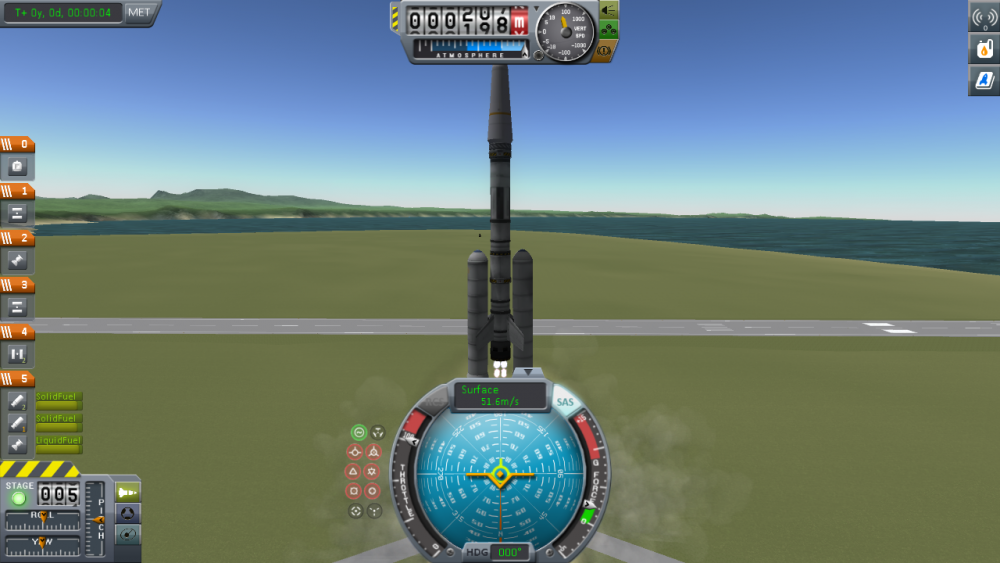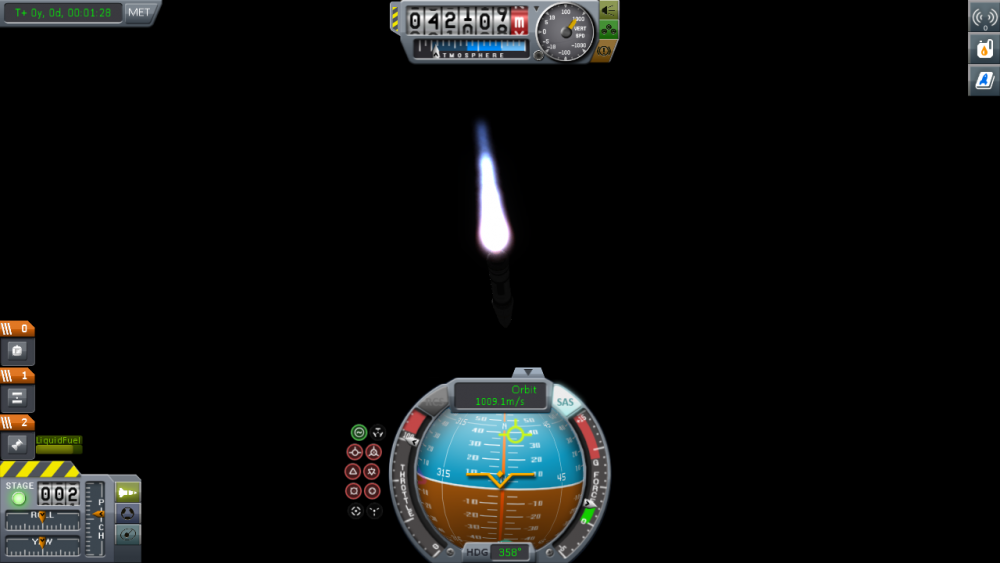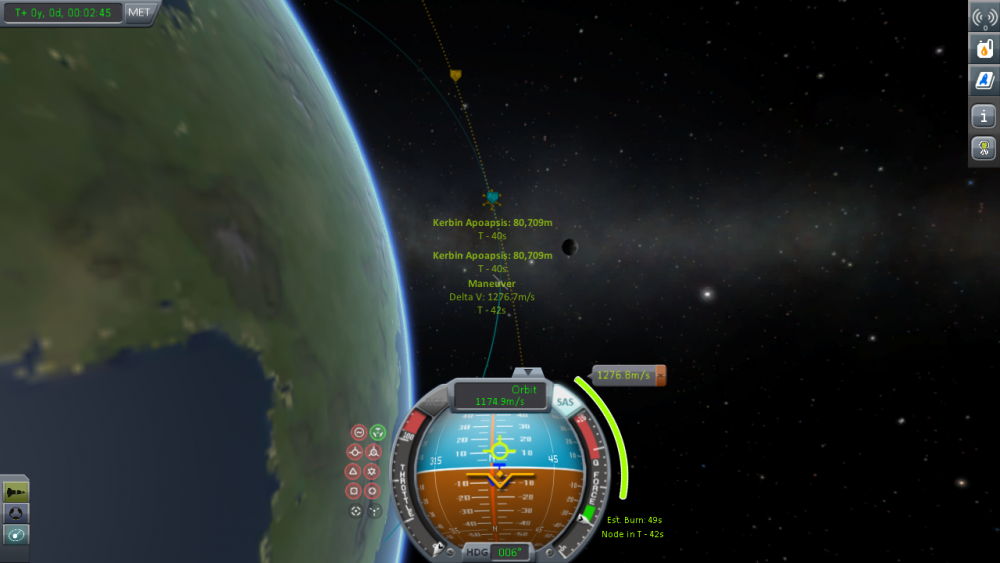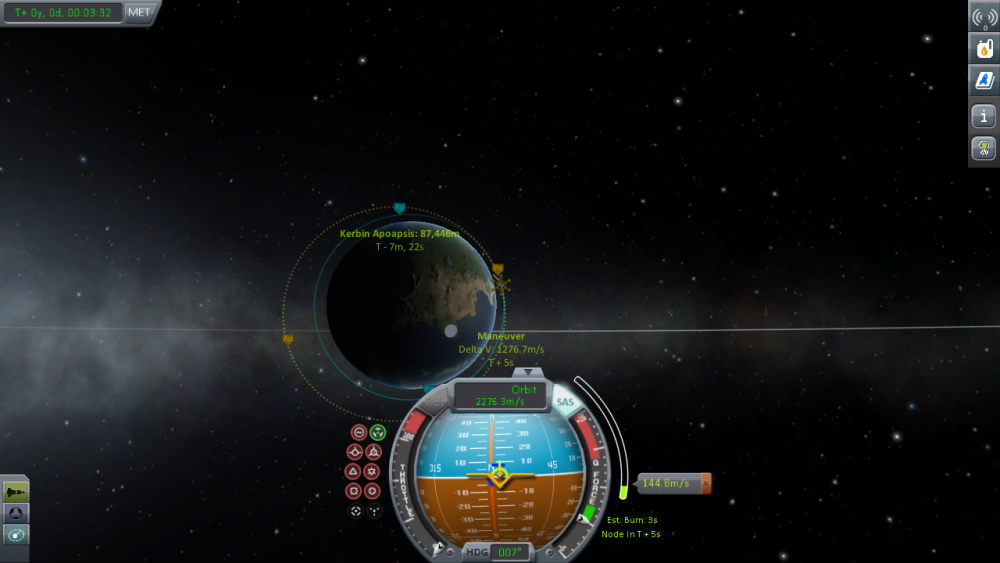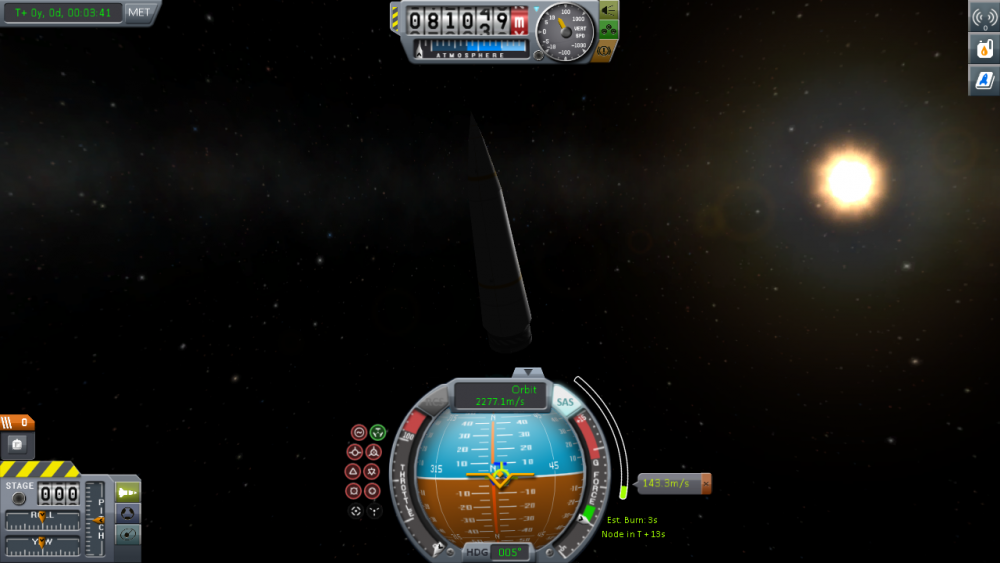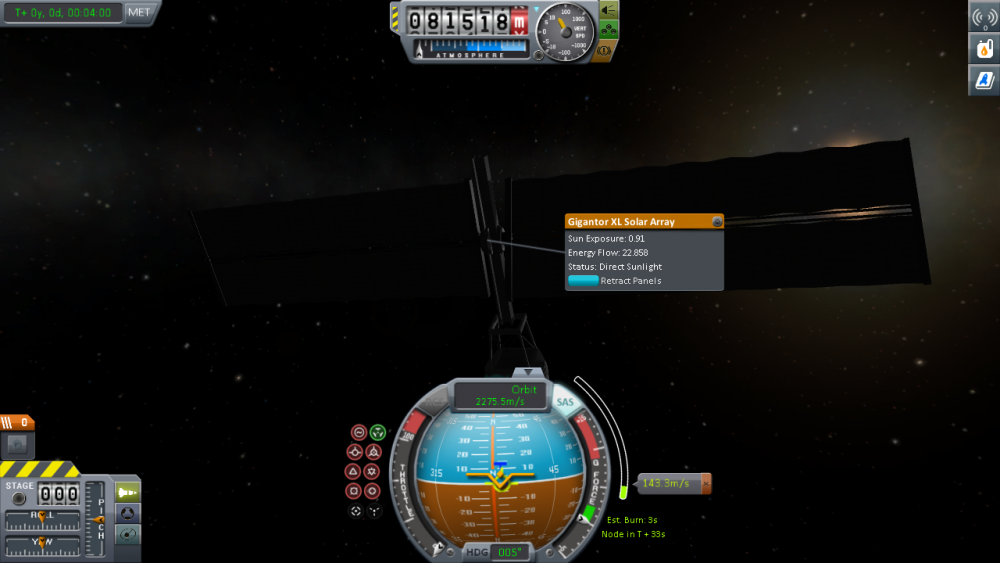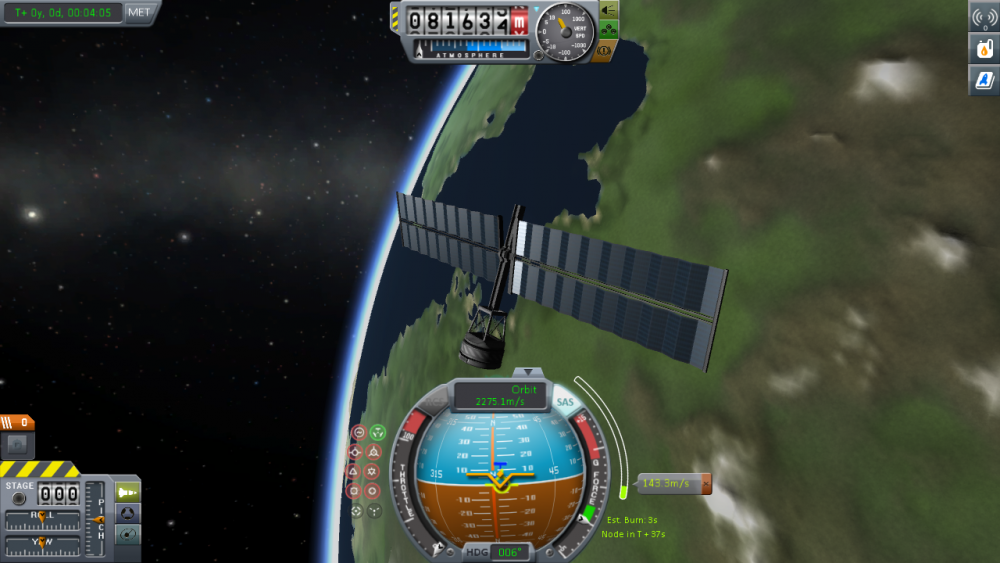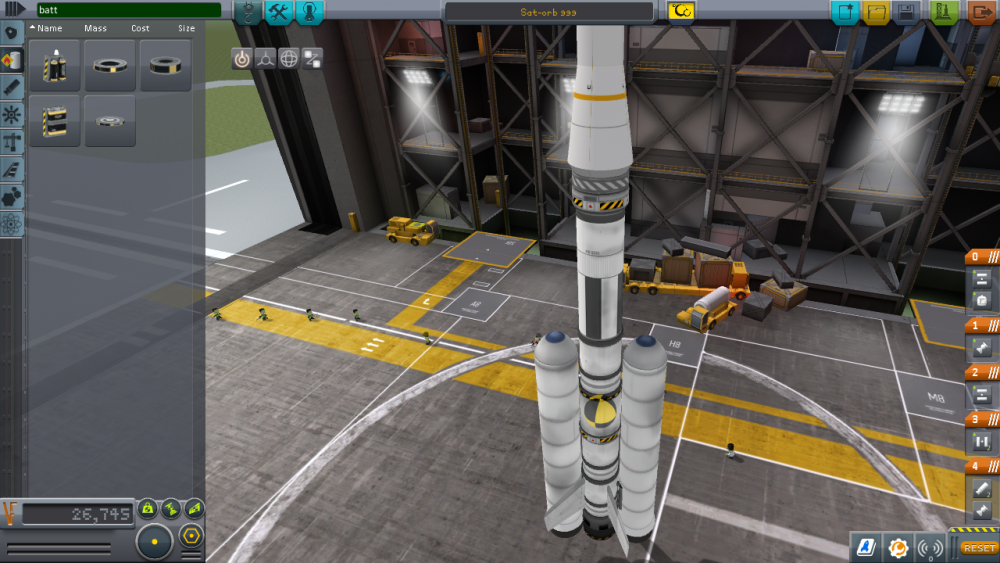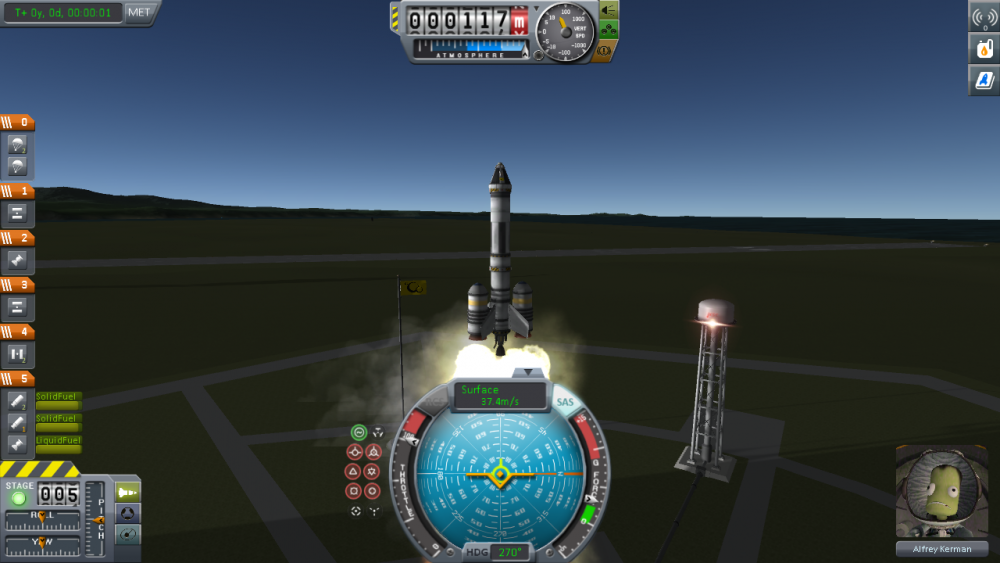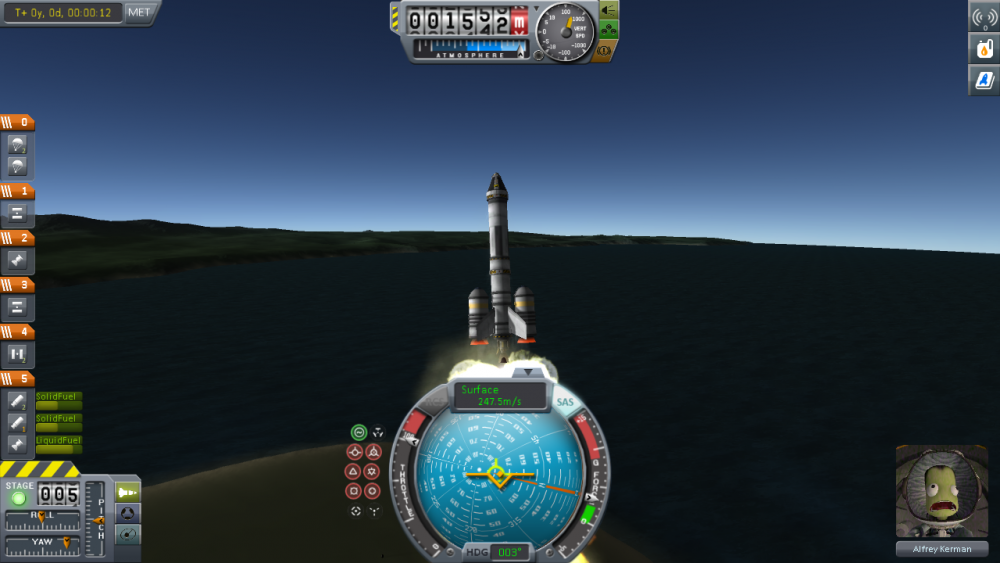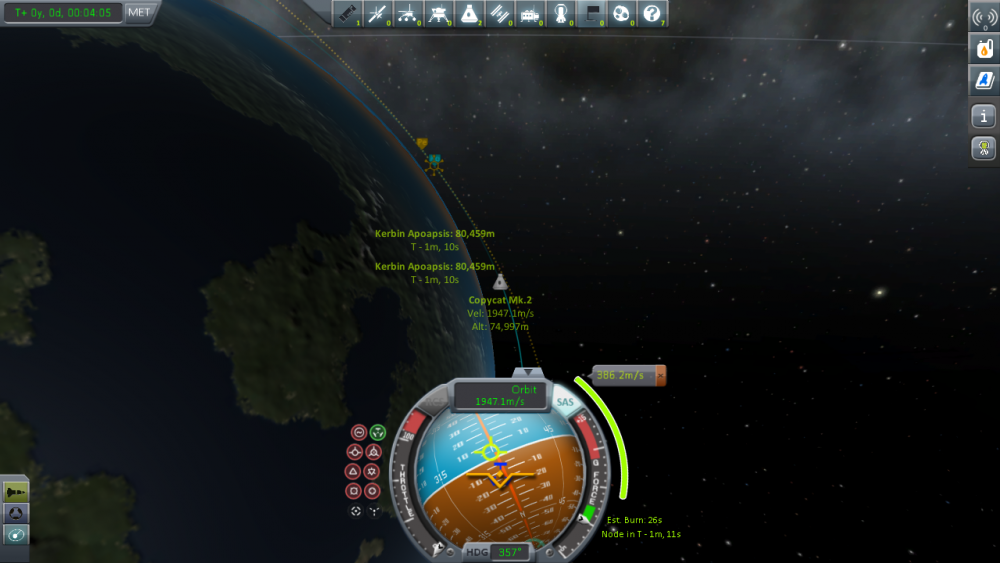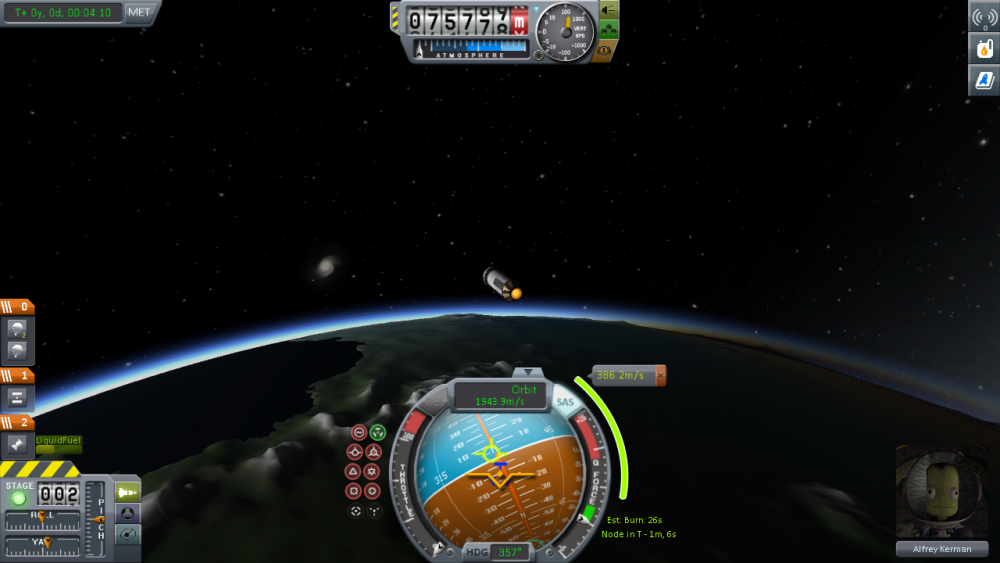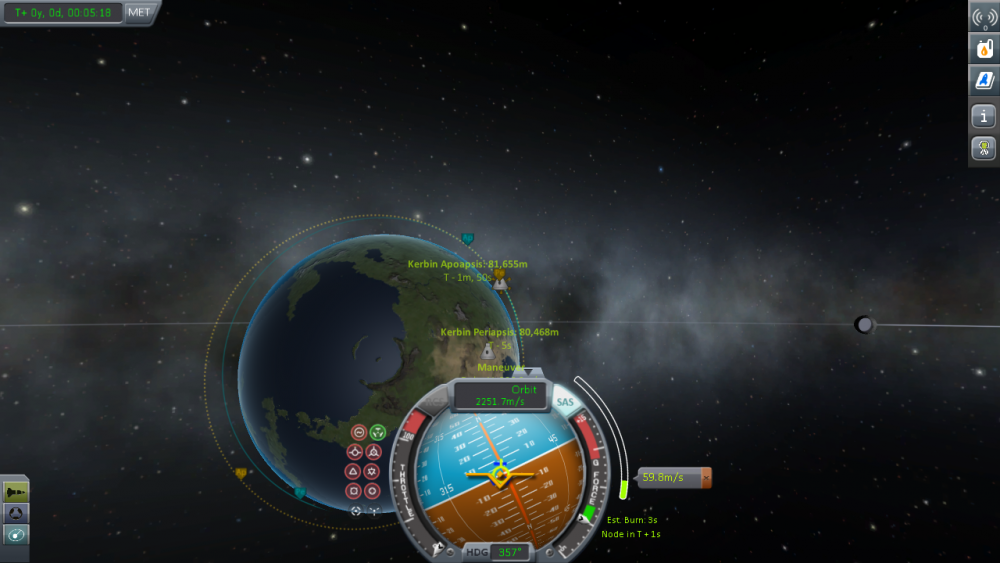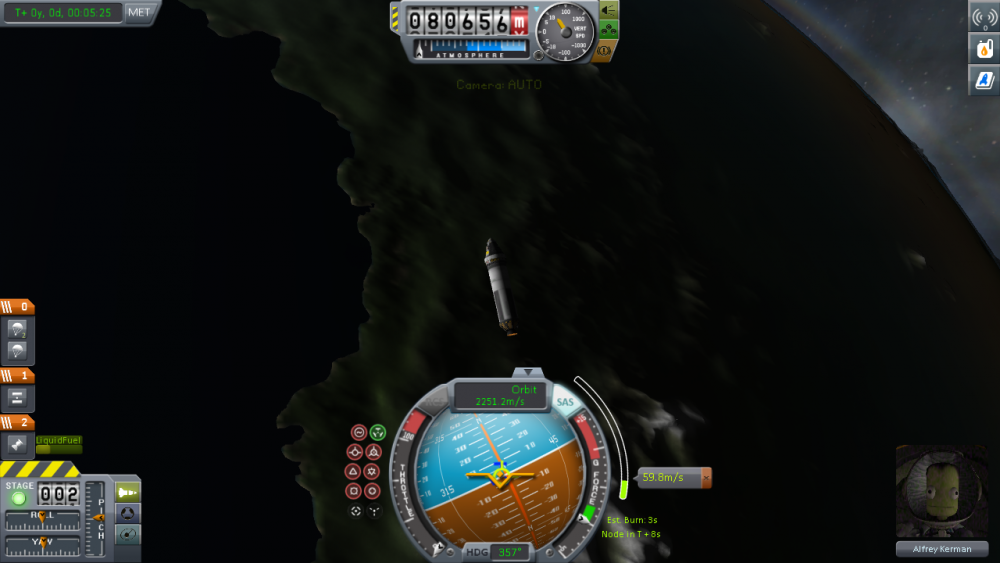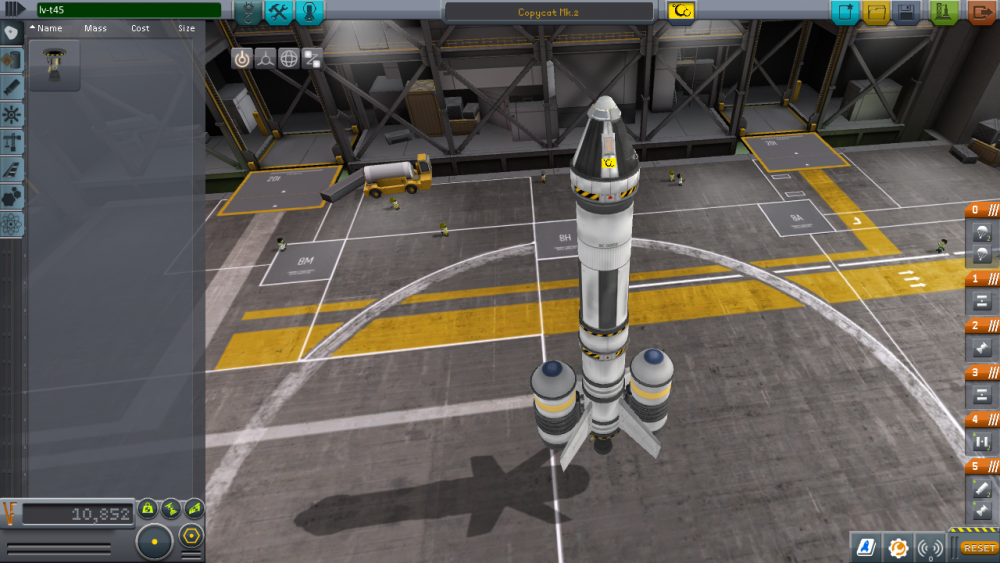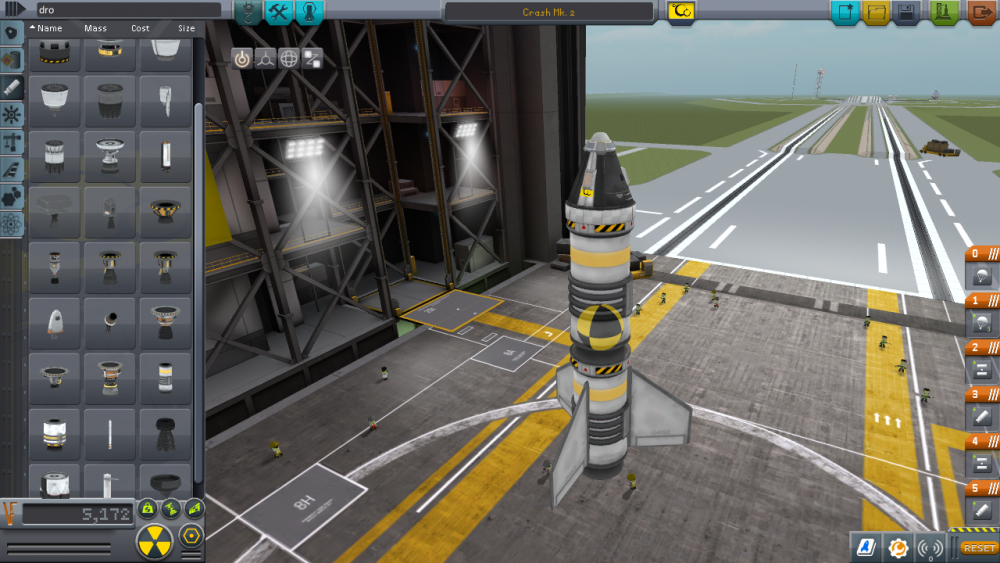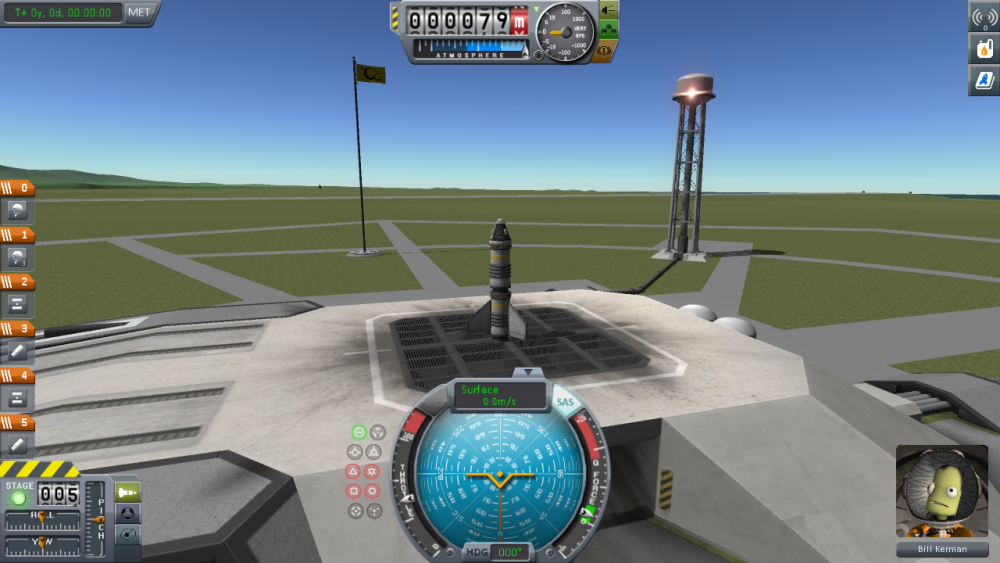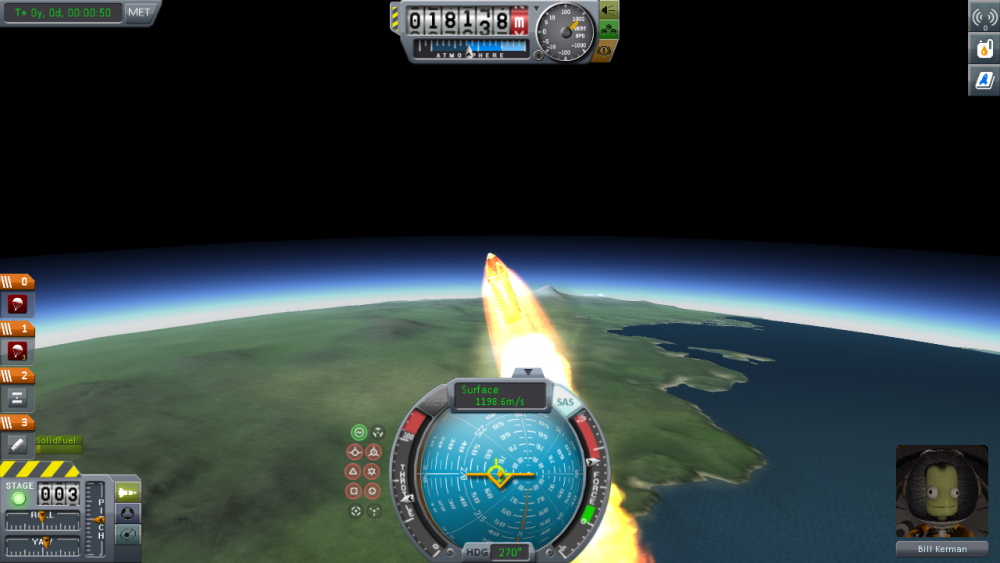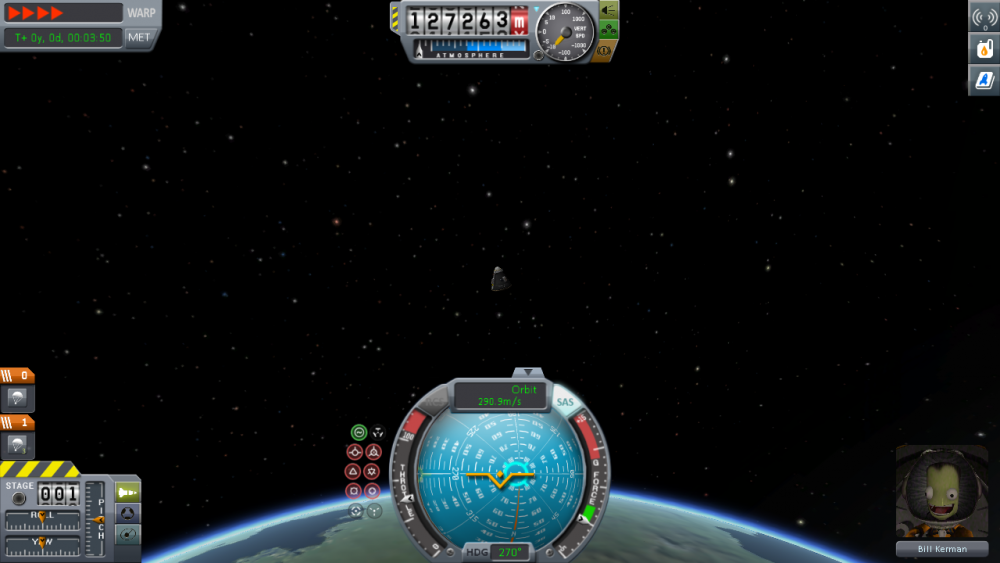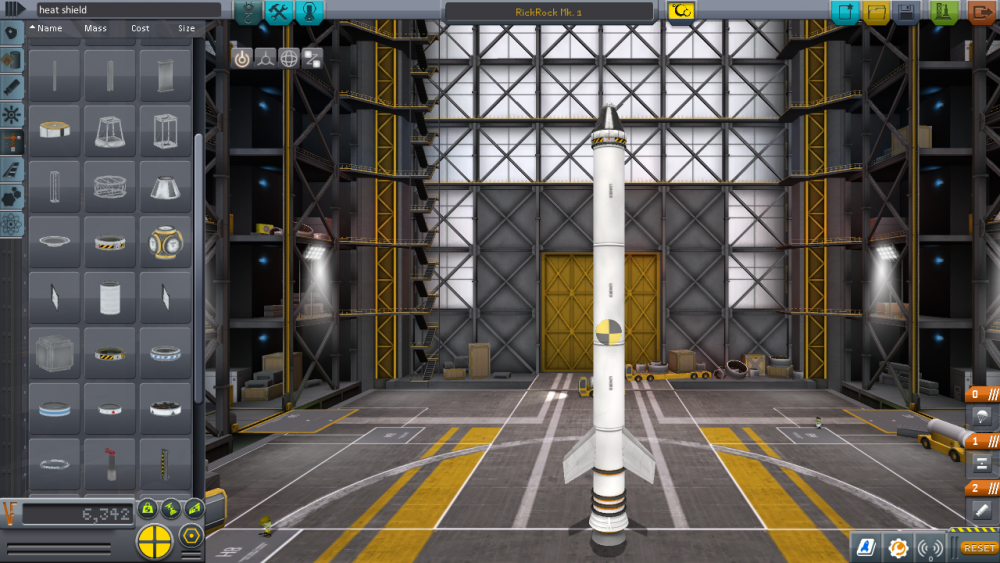
OcktoByte
Members-
Posts
39 -
Joined
-
Last visited
Recent Profile Visitors
The recent visitors block is disabled and is not being shown to other users.
OcktoByte's Achievements
Newbie (1/14)
0
Reputation
-
Post-Flight Launch Report Launch Time: 10:40 Members Present: Sean Preston, Justin Diehl, Nathan Kenney Play-By-Play: Used solid and liquid fuel boosters straight upwards until the rocket reached 60m/s, escaped atmosphere at around 10 degrees from horizontal, achieved orbit, and activated solar panels. Photographs: Time of Flight: 8m, 5s Summary: We were able to launch a satellite into orbit around Kerbin. Our rocket performed as expected. Opportunities / Learning: How to account for center of mass and weight of rocket components. Strategies: This achievement allows us more room to construct bigger and better rockets, including the possibility of a lunar mission. Milestone Awards: First working satellite placed in stable orbit - $80,000 Available Funds: $280,404
-
Preston Rockets $221,779 Sat-orb 999 Parts List: Gigantor XL Solar Array x2 = $6000 M-Beam 200 I-Beam = $25 Modular Girder Adapter = $50 AE-FF1 Airstream Protective Shell (1.25m) = $300 RC-001S = $2250 TR-18A Stack Decoupler x2 = $800 FL-T800 Fuel Tank = $800 FL-T400 Fuel Tank x3 = $1500 LV-T45 "Swivel" Liquid Fuel Engine -50% = $600 AV-R8 Winglet x4 = $2560 CR-7 R.A.P.I.E.R. Engine -50% = $3000 TT-38K Radial Decoupler x2 = $1200 BACC "Thumper" Solid Fuel Booster x2 -50% = $850 Aerodynamic Nose Cone x2 = $480 Z-1K Rechargeable Battery Bank x2 = 1760 Design Goals: This rocket is a modified version of our Copycat Mk. 2 meant to put a satellite into orbit. The thrusters have been upgraded to account for the increased mass of the payload. Launch Goals: We plan to get a remote controlled satellite into orbit around Kerbin. Pilot Plan: Similarly to our Copycat, we plan to use our solid fuel boosters to accelerate upwards, beginning to turn towards a 10 degree angle. We plan to detach the solid fuel boosters once they run out of fuel, and stage our main engine off once it runs out. Afterwards, our secondary thruster will allow us to reach a height allowing us to maneuver into orbit.
-
Post-Flight: Launch Time: 10:50 Play-by-Play: Rocket was able to escape the atmosphere. While ascent was shaky, stable orbit was achieved. A short EVA was performed once orbit was achieved. Photographs: Time-of-Flight: 0y, 0d, 00:07:30 Summary: The mission was a success. We achieved stable manned orbit, and performed an EVA. We faced the challenges of finding the correct angle to launch at in order to achieve our orbit, setting our course, and using thrust at the correct times. Opportunities / Learnings: The team learned that our momentum will carry us even if not using thrust, and how to use maneuvers to achieve the correct path. Strategies / Project Timeline: Achieving these goals gives us the funds to create larger rockets to reach further milestones Milestone Awards Presented: Achieving Stable Orbit - $40,000 Achieving Stable Manned Orbit - $50,000 First Kerbal EVA - $60,000 Available Funds: $221,779
-
Pre flight briefing #3 Team name: Preston Rockets available funds: $80236 Vehicle name: Copycat Mk2 Parts list: MK1 command pod-$600 MK16 Parachute-$422 2-MK12-R radial mound drogue parachute-$150 1.25mm Heat shield- $300 2-TR-18A Stack Decoupler- $800 LV-909 "terrier" Liquid fuel engine- $195 FL-T1800 Fuel tank-$800 2-Aerodynamic nose cone-$480 2-RT-10 "Hammer" solid fuel booster-$400 4-AV-R8 winglet-$$1560 LV-T45 "Swivel" Liquid Fuel Engine-$600 Total cost: $8457 Design goals: Orbit Kerbin and preform an EVA, We created a multi-stage engine and a strategy for getting in orbit in order to achieve this goal Launch Goals: our goals are to create a rocket capable of achieving orbit, and determine if we are able maintain stable orbit in our rocket. The launch goals we are hoping to achieve with this launch are achieving orbit and preforming an EVA. Pilot Plan: Fly at 90 degrees until velocity reaches 60 m/s, then begin turning slowly to 10 degrees. Once apoapis reaches over 80 km, cut engines and set maneuver to orbit Kerbin. Once stable orbit is achieved, perform short EVA outside of ship.
-
Pre-Flight Briefing #2: Team Name: Preston Rockets Available Funds: $25,008 Vehicle Name: Crash Mk. 2 Parts and Costs: Mk. 1 Command Pod ($600) Mk. 16 Parachute ($422) Heat Shield (1.25m) ($300) TR-18A Stack Decoupler ($400) x 2 = $800 RT-10 "Hammer" Solid Fuel Booster ($400) x2 -50% = $400 Delta Deluxe Winglet ($600) x 3 = $1800 Mk12-R Radial-Mount Drogue Chute ($150) x 3 = $450 Total: $4772 Design Goals: Designed to have an equivalent ascent, but a smoother and safer reentry. Using more parachutes and altering flight plan. Launch Goal: To have successful launch and landing after reaching 50km. Pilot Plan: Upward ascent to 50 m/s and begin tilting to 70 degrees, First decouple at 15km, Second decouple at 40km, Launched parachutes just over 400 m/s Screenshots: Post Flight Briefing #2 Preston Rockets Launch Time: 10:59 Team: Nate-Pilot Nisa Nathan Justin Play by Play: Launched first stage and began tilt to 70 degrees @ 15km First decouple when furl ran out Second decouple at 35km Max Height at 126km Began descent Deployed parachutes at about 400m/s Time of Flight: 29 minutes Summary: Our rocket was able to reach our goal of 50km, and landed safely. we reached a max height at 126km, and deployed parachutes at a speed of 400m/s, which allowed us to land safely. for our next flight, we would like to build a new rocket in order to enter orbit. Awards collected: award for reaching 10km, award for reaching 10 km manned, and award for reaching 50km manned Screenshots:
-
Team Name: Preston Rockets Available Funds: 30,000 Vehicle Name: RickRock Mk. 1 Parts and Costs: S1 SRB-KD25K "Kickback" Solid Fuel Booster (2700) -50% = $1350 Mk. 1 Command Pod ($600) Mk. 16 Parachute ($422) Heat Shield (1.25m) ($300) TR-18A Stack Decoupler ($400) AD-R8 Winglet (640) x3 = $1920 Total: $4,992 Design Goals: Vehicle is designed to reach 50km manned and land safely. Launch Goal: Successful liftoff and ascent from the ground. Safe return to surface after reaching 50km. Pilot Plan: Reach 50m at 90 degree angle, then tilt to 75 degrees, decouple thruster when out of fuel, ready parachute. Illustrations: Post Flight Briefing Preston Rockets Launch Time: 10:56 Team: Sean - Pilot Nisa - Reporter Nathan Justin Play by play: Launched rocket straight up tilted to a 70 degree angle at 100 meters continued ascending until 50km, when we detached thrusters reached a max height of 120000km began descent, overheated, and parachute burned up and crashed Screenshots: Time of Flight: 23 Minutes Summary: In our first launch we hoped to reach our first goal, a height of 50km, and were successful in this part of our plan. We reached a maximum height of 120,000km but upon reentry burned out our parachute and were unable to land safely, killing a Kerbal. In our next launch we will alter our flight path by easing into a smaller angle at a slower rate. additionally we will remodel our rocket to have more stability. Opportunities/Learnings: Angles matter significantly, need thrusters to counteract acceleration back into atmosphere Strategies/ Project Timeline: Financial Loss, a learning experience, will put more effort and research into next launch Milestone Awards Presented: None Obituary: A Reminiscent Haiku Upon re-entry, Valentina Kerman died. Parachute perished.
-
This post will delve less into video games and more into science fiction. Holograms are often shown in sci-fi movies and tv to show futuristic technology. Holograms are usually depicted as images created purely by light. Currently, we have digital projectors, able to display a color image on a flat surface. However, most holograms in pop culture have a 3d image. This would be difficult to accomplish realistically, since in order to create a 3 dimensional image, the light would need something to refract off of. The same way that a laser pointer will show a line through smoke or fog, but only shows a dot through the air. Creating a 3d hologram would require that light be refracted in specific regions in order to create an image. Figuring out a way to do this for a moving image, especially at a high framerate, would be difficult. I hope that one day technology advances to a point where I can see this happen.
-
Usually, when someone asks what superpower you would want, some say invisibility. It may be possible in the future to achieve this, however. The idea behind cloaking, as many seem to point out in the comments of the video, is fairly simple: bending light around an object such that you are unable to see it. In my opinion, Team Fortress 2 does this very well. The Spy class has an invisibility watch that allows him to cloak himself for brief amounts of time. However, if the spy comes in contact with an enemy or takes damage, his cloak will "blink" and an outline of his body will become visible. This makes some sense, as the cloaking device in the video requires careful calibration of the lenses in order to cloak an object, bumping into the spy might mess up his cloaking and cause him to blink.
-
The wall jump is a common term for the ability of a video game character to kick off of a wall to gain a bit of height. This technique is most common to platforming games, but can have its place in other genres. Usually, the character will jump between two parallel walls, but it is possible in some games to do a wall jump at a 90 degree corner. The most interesting thing about this is that it is technically possible. The trick relies on applying force on the wall and using momentum in order to push yourself up. Video game wall jumps are a bit less demanding on momentum, but nearly always show the character pushing off against a wall. It's interesting to see something some consider only possible in games done similarly in real life!
-
Metroid is a game known for its power ups. One of the lesser known ones from Metroid 2 for the Gameboy was the Spider Ball. This allows Samus, when curled up into a ball using her morph ball ability, to stick to walls and ceilings. Assuming that SR-388, the planet Metroid 2 takes place on, has gravity identical to ours, this power up would allow Samus to hold herself to walls with a force of over 882 newtons considering that the manual for Super Metroid lists her weight as 90 kilograms without her Power Suit.
-
Mario Kart 8 introduced a "zero gravity" feature where, in certain parts of tracks could be driven on upside down and sideways. This addition to the series is interesting though, as it isn't explained how this would function. The carts levitate above the track while in "zero gravity" mode, yet don't fall away from the stage. Also, while in this mode, you still have the ability to accelerate and decelerate. This should be impossible without some kind of force coming from the cart. Sure, there are some kind of thrusters, but these only visibly activate after using a speed item. Additionally, tracks at an angle to the force of gravity would have carts moving towards the force of gravity.
-
The main bosses of the Mega Man series are known as "Robot Masters". Each one has a theme, and a level to go along with that theme. For example, Gravity Man from Mega Man 3. As his name suggests, this robot is themed after the idea of controlling gravity. However, this should not be physically possible. Gravity is the result of large masses, such as planets and moons. In the game, this robot's level consists of "gravity" fields where you can fall towards the ceiling instead of the floor. If this were truly gravity, the level would not be able to "switch" gravity in specific places. Realistically, this would probably be an extremely strong magnet, but then we'd have a second Magnet Man.
-
Stardew Valley is a peaceful farming game in the same vein as Animal Crossing or Harvest Moon. Unlike these games, Stardew Valley runs on its own calendar rather than using a real life equivalent. Time in Stardew Valley is broken up into four seasons, with 28 days each. Each day has 24 hours, but a second in our time is equivalent to about a minute in Stardew Valley time. While this time difference is most likely for gameplay purposes, I'd like to discuss Stardew Valley as if the game took place on another planet. A year, one full revolution around our sun, would take about 44.8 hours in our time. Due to the exactness of the seasons in the game, the orbit of the planet would have to be nearly circular.
-
Most anyone who plays online games can tell you that ping, also known as latency, is one of the main factors to a smooth gameplay experience. Ping is the amount of time it takes for the input from your keyboard, mouse, or controller to reach the server running the game. This is usually measured in milliseconds, and the lower your ping is, the better. Good ping relies on a good connection to the server. This is dependant mainly on your internet connection and distance from the server. You'd get better ping connecting to a server close to you rather than one on the other side of the globe. Due to the limitations of physics, the speed of light in a vaccuum is 3x10^8 meters per second. This means that no matter what, ping will always be limited by distance. Even with the best fiber optic internet connection, you'd still see characters jittering around the screen if you connect across the globe.
-
One day, I was bored at my computer and decided to take a closer look at my mouse. This mouse has RGB lighting, meaning it can change between whatever color you could think of. However, the way these colors are produced has an interesting relation to physics. This mouse contains three separate LEDs. One controls the amount of red light produced, one for green, and one for blue, as indicated by the term RGB. Together, if each LED outputs light with a certain brightness, they can form other colors in between the standard red green and blue. Back to the story, I picked up my mouse which had a yellow color at the time. I decided to shake it around a bit, and noticed that when I did, I could see red and green strips of light. This is explained by a property of light which shows that light of different colors travel at different speeds. For example, red light travels faster than blue light. Knowing how something works is one thing, but seeing firsthand how that effect is achieved is another.
Terms of Use
The pages of APlusPhysics.com, Physics in Action podcasts, and other online media at this site are made available as a service to physics students, instructors, and others. Their use is encouraged and is free of charge. Teachers who wish to use materials either in a classroom demonstration format or as part of an interactive activity/lesson are granted permission (and encouraged) to do so. Linking to information on this site is allowed and encouraged, but content from APlusPhysics may not be made available elsewhere on the Internet without the author's written permission.
Copyright Notice
APlusPhysics.com, Silly Beagle Productions and Physics In Action materials are copyright protected and the author restricts their use to online usage through a live internet connection. Any downloading of files to other storage devices (hard drives, web servers, school servers, CDs, etc.) with the exception of Physics In Action podcast episodes is prohibited. The use of images, text and animations in other projects (including non-profit endeavors) is also prohibited. Requests for permission to use such material on other projects may be submitted in writing to info@aplusphysics.com. Licensing of the content of APlusPhysics.com for other uses may be considered in the future.

